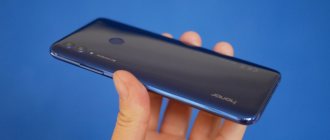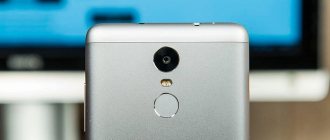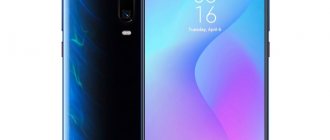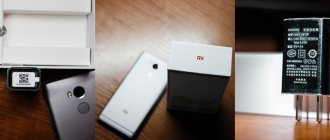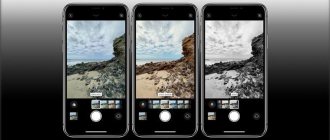Front-camera
The front side of the device houses not only important sensors, but also a dedicated selfie camera – the front camera.
The initial purpose of the front camera is video communication. In devices that did not have a peephole on the front panel, this was very inconvenient, because you could either look at the screen or broadcast your image. The use of a camera to take pictures of your face at arm's length (selfie) has gradually gained popularity. In this regard, manufacturers have focused on installing a good module for front shooting. In some devices, the front camera is superior in quality to the rear matrix. They are called “selfiphones”.
For convenience, the camera is placed on the top of the smartphone; there are also models with a bottom location, but according to reviews this is inconvenient.
Differences from the main (rear) camera
HDR function
The front camera is very different from the main one. The differences are as follows:
- The sensitivity of the matrix is 2-3 times less than that of the main one. Because of this, the quality of the images suffers.
- Autofocus and flash are often missing because they are not needed.
- Reduced aperture (f/2.2 and larger). Because of this feature, you need to ensure good lighting before making video calls.
- Fewer shooting modes, lack of face detection, HDR, etc.
These shortcomings are eliminated in selfies - smartphones with a full-fledged front camera module, whose characteristics and additional functions are superior to those of the main camera.
Camera quality
To get good photos of your loved one, you need to pay attention to the camera resolution and aperture width. In this case, the second indicator is very important.
- Resolution is the number of light-sensitive points in the camera. There is an opinion that this is a key indicator, but this is not entirely true.
- Aperture - the width of the lens and the size of the area that transmits light to the main element.
These two indicators complement each other perfectly.
The wider the camera, the more pixels it can accommodate comfortably.
If you insert 20 million dots into a circle with a diameter of 1 mm, then they will be cramped, their size will be less than normal in order to achieve the number for the sake of compactness. The situation will change if you expand the size of the work area or reduce the number of points.
A wide camera window allows you to receive more light during shooting, and accordingly the clarity and brightness of the photo will be better than the same one, but with a smaller aperture.
The optimal resolution for a camera is 10-12 megapixels. It is worth taking more only with an increased diameter of the eye. Some manufacturers deliberately add black edging or glass to make the window appear larger.
The world of mobile photography is changing rapidly. Every year, smartphone cameras demonstrate greater capabilities in terms of shooting quality, and now a smartphone can safely be called a full-fledged photographer’s tool. Many famous photography masters actively use smartphone cameras, and some have even made a name for themselves in mobile photography. But nevertheless, until recently, when taking photos with smartphones, we were faced with significant limitations, and one of the main ones was the lack of variability in focal lengths. Older generation smartphones were equipped with a single camera with a fixed viewing angle. And if it was possible to narrow it, albeit “artificially”, through digital zoom, then expand it - in no way. The emergence of smartphones with multiple built-in cameras was a real breakthrough. In particular, owners of smartphones with an ultra-wide-angle lens, such as the Huawei P30 Pro, have more opportunities to realize their creative ideas. Let's see how it can be useful to a photographer.
1. Fit more objects into the frame.
This is probably the least creative use of a wide-angle lens, but it is nonetheless the most practical. Agree, there are often situations when you want to capture several objects in one frame or show both an object and the background on which it is located. There is not always an opportunity to leave. Another current situation is shooting objects located on a table from the top point. Sometimes you have to rack your brain about what to stand on in order to stand taller and fit everything you need into the frame. In this case, turning on the wide-angle camera helps a lot: you remain in your place, but much more fits into the frame!
Both shots were taken from the same point. The first is for a standard camera, the second is for a wide-angle
2. Shooting in tight spaces.
In fact, this is a continuation of the previous topic. Often the space itself limits our ability to take a full-length photograph or capture several people in the frame, while we want to show not a fragment of the scene, but the plot as a whole, so that the person looking at the photo can understand what is happening and where, who is participating in the events. A wide angle may distort the proportions of people in the frame, but everything you need will fit!
The photo was taken from the seat next to me on the tram. Using a wide angle allowed us to capture both the model and the shadow on the wall in the frame without making the composition look cramped.
3. Create a feeling of spaciousness.
Even if you are photographing in a not very cramped room, a wide angle will not be superfluous. Short focal length lenses are often used in interior photography not only to ensure that “everything fits” into the frame, but also to create the illusion of a large, spacious room. These are the kinds of pictures you can see in advertisements for hotels, restaurants, and apartments for rent. Therefore, if you want to impress the viewer by showing what a chic place you are in, it makes sense to use a wide-angle camera.
Beautiful interiors look even more impressive when shot at wide angles.
4. Landscape photography. Wide-angle and ultra-wide-angle lenses are traditionally used when shooting landscapes - they allow you to capture a large amount of space, interesting details into the frame, and show the versatility of the composition.
Shooting at an ultra-wide angle can often add interest to a landscape.
5. Accentuate the subject in the frame
There are different ways to focus the viewer's attention on a specific object in a photograph. Often, long-focus optics are used for this and the background is blurred as much as possible. The reception is good, but not always suitable. What if the background is important too? If it is important to show an object in the context of its environment? To prevent him from getting lost in the frame, photograph him with a wide-angle lens, placing him in the foreground. Thanks to optical distortions, an object, even if it is very small, will appear large in the photo. In this case, the surroundings will also remain in the frame, adding information to the picture.
Shooting at close range with a wide-angle lens allowed the small bouquet to become the main focus of the frame, although in reality it was lost against the backdrop of the monumental landscape.
6. Playing with scale
So, we have already mentioned the property of wide-angle optics to distort the proportions of objects: what is close to the lens will be large in the photograph, and more distant objects, even if they are larger in reality, will turn out small. This technique can be used creatively, playing with scale in the frame and creating unusual compositions. Don’t forget to choose the right angle! Try to shoot the object from the level of the surface on which it is located or slightly below - this will emphasize its size.
Any subject can be shot interestingly if you choose the right angle and focal length.
7. Cartoon portraits
Of course, you can use the property of wide-angle optics to “stretch” perspective in portrait photography. As a rule, we strive to ensure that the proportions of the person or animal in the frame are correct, but sometimes you can create a portrait in a humorous way by deliberately distorting the proportions. Try taking a photo with your smartphone's wide-angle camera from as close as possible. If you hold the camera directly in front of the model’s face, the nose will be as large as possible; if you shoot from above, the eyes will be as large as possible. If your character additionally makes faces on camera, you will get a finished cartoon.
It’s fun to shoot not only people, but also animals at a wide angle, emphasizing their natural features: for example, making a cat have exaggeratedly long paws in the picture.
8. Unconventional selfies
Continuing the portrait theme - everyone's favorite selfies. Everyone’s favorite, but already somewhat boring: there are few options - the face is a little on top, the face is a little on the side... But what if you approach the process more creatively? Turn on the wide-angle camera and timer mode. This way you can free up your hands and include them in the composition of the shot. Remember that the object closest to the camera will be as large as possible, and you can play on this.
Self-timer + wide-angle shooting - an option for those who are tired of monotonous selfies on Instagram
9. Add speakers
Photos in which the eye moves rather than freezes at one point look more interesting. Diagonals help the eye move - these can be natural lines of architecture, roads, wires, etc. Parallel lines shot with a wide-angle lens appear rapidly converging in the frame, and seem to lead the viewer from the corner into the depths of the picture. Therefore, even a plot that is static in content will look livelier and more dynamic when using wide-angle optics.
The presence of lines in the frame helps to organize the composition.
Problems at work
Reasons for front camera failure:
- Software Update. The system software may not be finalized. This is especially common in new phone models or unknown Chinese brands.
- Viruses. Your phone may be infected with malware that interferes with components and can collect personal information.
- Mechanical damage. Physical impact may affect the condition of the module and the sensitivity of the components.
- Dust and dirt getting into the device body. Microscopic particles can cause the contact between the die and the main board to break.
- Cache clogged. To operate the camera, a certain amount of internal memory is allocated, which is necessary for displaying the image on the screen, processing photos and working. During use, special “traces” may remain, which accumulate and thereby slow down the work.
to fix operational problems yourself :
- Reboot the device. The malfunction may be caused by a minor disturbance that will go away after the system is restarted. The device charge must be at least 30%, because some models have restrictions on the use of the camera and flash.
- Reset settings to factory settings. Before doing this, you need to save all important information and files. All installed applications will be removed, including malicious programs.
- Clearing cache memory. Go to Settings – Applications – Camera – Data – Clear cache. The procedure will help speed up the operation of the device.
- Remove viruses. Installing special software, an antivirus, will eliminate the threat introduced from the outside.
If the device refuses to take photographs after all procedures have been carried out, then the problem is most likely hidden in the physical state of the module. You should check the connection of the contacts, remove dust and debris, or replace the entire module.
Installation work requires precision and is best left to a professional. When contacting the service center, you need to describe the problem to a specialist. If you have a suitable module, the procedure will not take much time.
Disadvantages of under-screen cameras
On June 26, 2020, a presentation of the Oppo smartphone took place, in which the front camera is hidden in the screen. But everything is not as perfect as we would like. Especially for selfie lovers. The fact is that photographs taken with a camera under the screen will be noticeably inferior in quality to photographs taken with conventional cameras. Oppo Vice President Brian Shen warned about this at the beginning of the month in his microblog. For this reason, you should not expect that smartphones with an innovative arrangement of the front photo module are about to go on sale. The development of the technology is still not completed; the exact timing of the completion of this process is unknown. We are talking about showing a prototype, and this is evidenced by the fact that we still do not know the name of the device. However, the manufacturer himself previously said that it is unlikely that smartphones with under-screen cameras will be released to the masses before 2020.
Thus, we come to the conclusion that 21st century technologies do not stand still. Perhaps in the near future, such smartphones with an improved camera under the screen will be put into mass production and will become as convenient and practical as possible. Such devices will replace the phones we are used to with external photo modules.
- Author: Elena
Rate this article:
- 5
- 4
- 3
- 2
- 1
(2 votes, average: 1.5 out of 5)
Share with your friends!
For selfie lovers
If the front camera has stopped responding to the smartphone owner's requests or is missing, you can take a photo with the rear camera.
Some devices of the past had a small reflective disk near the aperture window, this was a special mirror for selfies. As a life hack, you can use a small cosmetic mirror, which should be placed on the back wall. It is convenient to set a timer for 5 – 10 seconds. This will allow you to take the necessary facial expression to achieve the best effect.
The selfie camera provides great opportunities and greatly simplifies multimedia shooting.
For long-term and high-quality operation, it is necessary to monitor the condition of the device, regularly wipe the display and camera cutout, and prevent moisture from getting inside the case.
Honor 30i unboxing and first impressions
Since the summer, three smartphones of the Honor 30 line have been sold in Russia, and recently the fourth model appeared - Honor 30i. You can't buy it yet (you can pre-order it until September 18), but we already have it. Now let's see what's inside and what's interesting about this smartphone, and we'll definitely publish a detailed review later.
Video
What are the characteristics
- SoC Kirin 710F, 8 cores
- Operating system Android 10, MagicUI 3, without Google Play Services
- OLED display 6.3″, 2400×1080
- Random access memory (RAM) 4 GB, internal memory 128 GB
- No microSD support
- NM (Nano Memory) card support
- Nano-SIM support (2 pcs.)
- GSM/WCDMA/WCDMA/TD-SCDMA/LTE-A, 5G networks
- GPS/A-GPS, Glonass, Baidu
- Wi-Fi 802.11a/b/g/n/ac, dual-band, Wi-Fi Direct
- Bluetooth 5.1, A2DP, LE
- NFC
- USB 2.0 Type-C, USB OTG
- 3.5mm audio output
- Camera 48 MP (f/1.8) + 8 MP (f/2.4) + depth sensor 2 MP (f/2.4)
- Front camera 16 MP (f/2.0)
- Proximity and lighting sensors, magnetic field, accelerometer, gyroscope
- Fingerprint scanner (optical, under the screen)
- 4000 mAh battery, 10 W fast charging
- Dimensions 157.2 × 73.2 × 7.7 mmmm
- Weight 171.5 g
What's inside the box
- In Russia, Honor 30i has the following equipment:
- the Honor 30i smartphone itself;
- flexible transparent case;
- ;
- 10 W charger;
- USB-A to USB-C cable.
The flexible cover is easy to put on and take off. Obviously, it also performs a protective function well. It is slightly matte, but it does not hide the beauty of the smartphone (more on that below).
What does it look like
We received a sample in the color Phatom Blue, which was translated into Russian as “shimmering blue”; there are also “midnight black” and “ultraviolet sunset”. This “shimmer blue” looks really nice. At first, Honor designers were too carried away by the “glitter”, but with the latest models they have definitely found a balance between pretentiousness and restraint. But it’s worth considering that all this beauty gets dirty on your fingers very quickly.
The camera protrudes above the back panel, but only slightly. And if you put on a cover, then this protrusion will not be there.
The front panel is also flat. The Honor website talks about “2.5D glass”, but for those who don’t like “waterfall screens”, don’t worry, the edges are very slightly curved.
On the right side are the volume control buttons and the power key. The latter is simple, without a fingerprint scanner, like some other recent Honor models. Instead, the Honor 30i has an optical under-screen scanner. They usually do not work as quickly and not as clearly as classic ones, but in the 30i, unlocking almost always happens the first time, recognition takes less than a second. Well, of course, you can set up unlocking by the owner’s face. Or remain retrograde and always enter the password.
At the bottom there is a speaker, a microphone and a USB Type-C connector (it’s 2020 after all). On the top there is an additional microphone (it is needed for noise reduction) and - hurray! — 3.5 mm headphone jack. The perfect set.
The frames around the screen are not very wide, although the “chin” is noticeable at the bottom. The front camera is located in a drop-shaped notch. There is a protective film glued to the screen; you should not remove it before using it (but if it gets scratched, it can, of course, be replaced).
On the left side there is only a slot for two nano-SIM cards. There is nowhere to put a microSD card. Although Honor 30i formally supports NM Card, it is almost impossible to buy these flash drives in Russia. In short, Honor 30i does not actually support memory expansion. It has 128 GB of its own storage, and if that’s not enough, welcome to the cloud.
What software
Honor 30i runs on Android 10 with the proprietary MagicUI 3.1.0 shell. There are no Google services here; as a replacement, the manufacturer offers its own services, including the AppGallery application store. Most popular programs in Russia can be found there; there are clients for the entire Yandex ecosystem, Mail.ru sites, and domestic social networks. What is not there can be found in archives like APKPure or APK Mirror. But you need to understand that there are applications that, in principle, cannot work without Google Mobile Services. There is nothing you can do about it - just look for a replacement, use web versions (if available) or wait.
What kind of iron
The platform in Honor 30i is Kirin 710F. On the one hand, I would like something more recent, on the other hand, this SoC produces about 380 thousand points in the same AnTuTu. And in general, the smartphone behaves very well, the interface does not slow down, applications launch and switch quickly.
The SberPay payment service from Sberbank has appeared on Honor smartphones. We answer the main questions
We’ve already talked about memory, but for those who read paragraph by paragraph, we’ll repeat: 4 gigabytes of RAM, 128 GB of flash storage.
NFC is supported, but you won't be able to pay via Google Pay. Instead, you can use the Wallet, Yandex.Money or Sberbank Online applications.
Battery capacity - 4000 mAh. Fast charging with a power of 10 W is supported (this is the adapter included in the kit). Honor 30i does not support wireless charging.
What cameras
The main camera is triple, but one of the modules is a depth sensor with a 2 MP matrix and cannot take photographs on its own. The other two modules are a 48-megapixel main camera (by default, it combines adjacent points and produces 12-megapixel images) and an 8-megapixel wide-angle camera. The front camera has a 16 MP sensor. Both the rear and front cameras support portrait and night modes. Since this is too broad a topic, we will not touch on it in the “unpacking” and ask you to wait for the full review.
Summary of first impressions
The Honor 30i looks like an improved and modernized version of this spring's inexpensive Honor smartphones, such as the Honor 9C. It has the same platform, the same battery, approximately the same screen size, but the Honor 30i uses an AMOLED matrix, has more flash memory, and has a USB Type-C connector. Plus there is support for Wi-Fi in the 5 GHz band, which the 9C did not have. The new smartphone costs 17,990 rubles (if you pre-order, you will receive an Honor Watch Magic smartwatch as a gift), and based on first impressions, it can be cautiously called one of the best Honor models in the low-middle price segment.
| Learn more about the Honor 30i smartphone |
Google Pixel 3
Pixel 3 made it into our top 10 phones with a good camera even though it has only one main camera, which, however, did not prevent it from achieving good results. The company clearly shows that the main thing is not quantity, but quality, focusing on good software algorithms and artificial intelligence, which allows you to get the most out of the camera's capabilities.
An example is the Top Shot feature, which takes multiple photos and allows the user to choose the one with the best exposure. This approach makes the Google Pixel 3 a good choice for those who are interested in mobile photography and want to get high-quality results under any conditions. In addition, the model runs on pure Android and performs any functions with lightning speed thanks to powerful hardware.
Huawei Mate 30 Pro
The first, but not the only representative of Huawei smartphones in the top ten of the DxOMark smartphone camera rating. It has a 6.53-inch OLED display, a 4500 mAh battery and a chipset with the latest science and technology - Kirin 990.
On paper, the “filling” of the main camera with Leica optics is exactly the same as last year’s model – the same 40 MP sensor. Alas, the Huawei Mate 30 Pro has lost its telephoto lens with five times magnification; instead, the smartphone houses a 3x zoom module, very similar to the one found in the “non-pro” version of the P30.
However, this miss is compensated for by the latest wide-angle camera: although it is only 18 mm, it has a wide 1/1.54-inch sensor, F1.8 and an unusual aspect ratio of 3:2.
Let’s add that the computing power of the smartphone is also put to use for the camera. The new powerful chipset has made it possible to introduce the Al-RAW algorithm, which processes information received from the camera sensors and converts them into an image with less noise and a greater level of detail.
Examples of photos from the camera.
Pros : there is a slot for a memory card, there is fast and wireless charging, the 32 MP front camera produces bright selfies without color distortion and with good white balance.
Cons : no 3.5 mm audio jack.
Xiaomi Mi 10 Pro
The older version of one of the new Chinese smartphones of 2020 is equipped with a 6.67-inch OLED display with a refresh rate of 90 Hz, a Snapdragon 865 chip and a 4500 mAh battery with support for fast, wireless and reverse charging.
However, it was not these advantages that helped the Xiaomi product surpass its competitors in the ranking of smartphone cameras in 2020, but a set of excellent high-resolution optics and support for shooting at 8K resolution. Rear camera includes:
- 108 MP main sensor (shoots at 25 MP resolution by default), has laser autofocus and optical stabilization.
- The second module with a resolution of 20 MP is ultra-wide-angle.
- 12 MP – telephoto with 2x optical zoom and instant autofocus with Dual Pixel technology.
- 8 MP is another telephoto lens with laser autofocus, optical stabilization and 10x hybrid zoom.
Overall, the photography results are similar to last year's Mi CC9 Pro Premium Edition, but thanks to a more powerful Snapdragon 865 chipset, wider dynamic range and improved settings (especially in terms of texture rendering, HDR processing in bright outdoor and typical indoor environments, shooting quality in night mode and corner sharpness), the performance of the Mi 10 Pro model is optimal for creating high-quality photos and videos.
The 20 MP front camera supports face unlock and can record video at 120 fps.
Examples of photos from the camera.
Pros : Excellent stereo speakers, cooling system with 9 temperature sensors.
Cons : screen scratches easily, no memory card support, no 3.5mm jack. The global version of the device supports only 1 SIM card.
iPhone Xs Max
The Apple smartphone is traditionally equipped with one of the best cameras, but if in terms of photos it is inferior to Huawei’s flagships, then it records video best of all. Good detail is facilitated by the increased pixel size - 1.4 microns, as well as a pair of high-quality sensors with a resolution of 12 megapixels and aperture F / 1.8 + F / 2.4. Video is recorded in 4K 60 FPS and FullHD 240 FPS. The front camera also copes well with its task and can create spectacular bokeh.
Results of the ranking of phones with the best camera
In 2020, the camera has become one of the main factors when choosing a new smartphone. This is not surprising, because the difference in photo quality with professional cameras becomes almost unnoticeable, which means there is no need to buy two devices separately, especially since the phone is compact and always with you. After looking at our rating of models with the best cameras for taking photos and videos, you are guaranteed to find a good option for purchase in 2020.
Even more interesting:
|
Comments for the Cackl e
You might be interested in:
